
Hunting for the Building Blocks of the Universe – with VAT Vacuum Valves
VAT has a long-term collaboration with CERN, the largest particle physics laboratory in the world. Sector valves developed by a dedicated VAT team help keep the ultra-high vacuum (UHV) conditions within CERN’s Large Hadron Collider (LHC) intact. (3 min. read)


